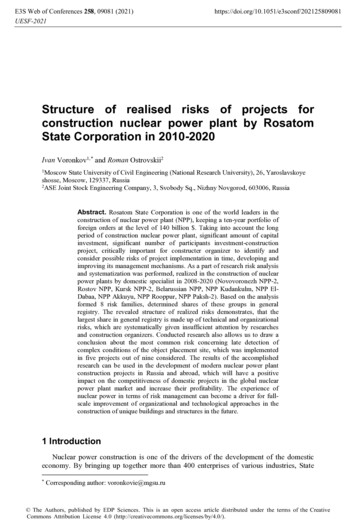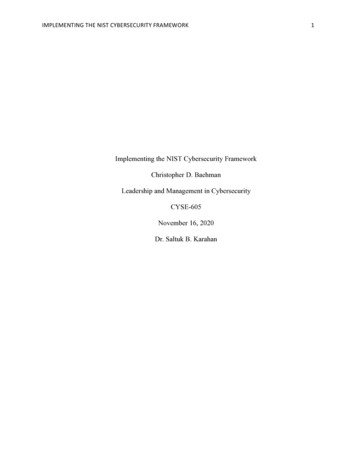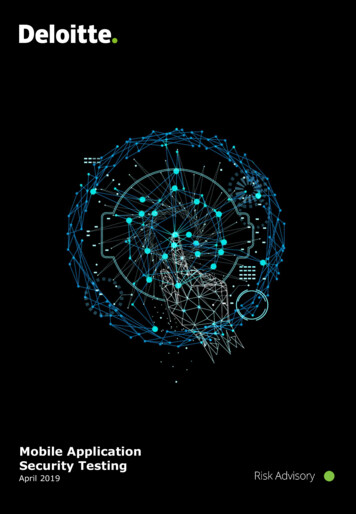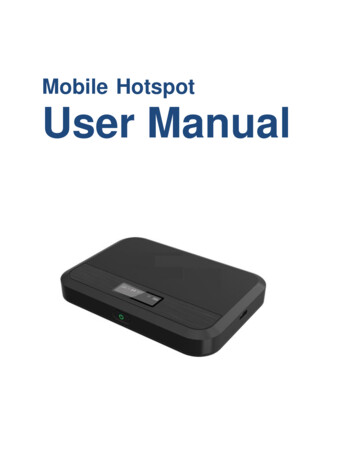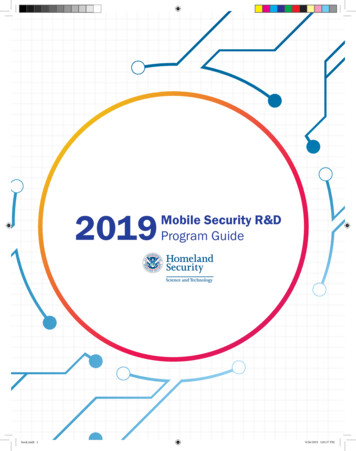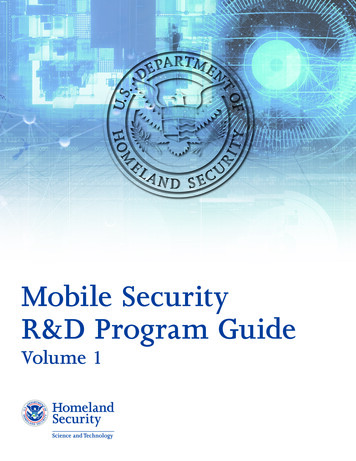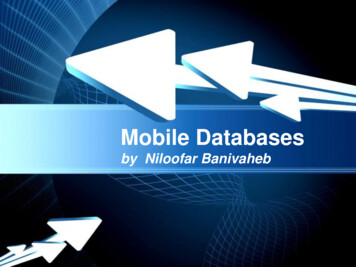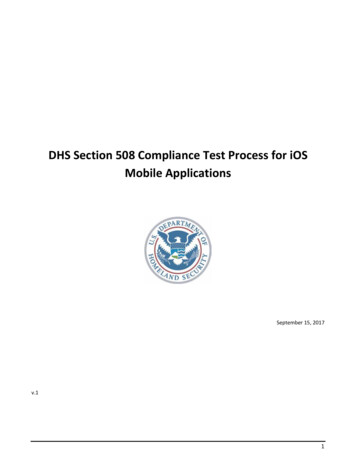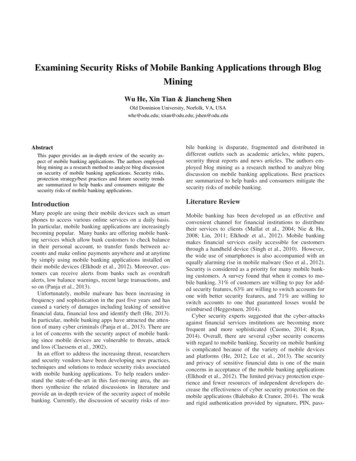
Transcription
Examining Security Risks of Mobile Banking Applications through BlogMiningWu He, Xin Tian & Jiancheng ShenOld Dominion University, Norfolk, VA, USAwhe@odu.edu; xtian@odu.edu; jshen@odu.eduAbstractThis paper provides an in-depth review of the security aspect of mobile banking applications. The authors employedblog mining as a research method to analyze blog discussionon security of mobile banking applications. Security risks,protection strategy/best practices and future security trendsare summarized to help banks and consumers mitigate thesecurity risks of mobile banking applications.bile banking is disparate, fragmented and distributed indifferent outlets such as academic articles, white papers,security threat reports and news articles. The authors employed blog mining as a research method to analyze blogdiscussion on mobile banking applications. Best practicesare summarized to help banks and consumers mitigate thesecurity risks of mobile banking.IntroductionLiterature ReviewMany people are using their mobile devices such as smartphones to access various online services on a daily basis.In particular, mobile banking applications are increasinglybecoming popular. Many banks are offering mobile banking services which allow bank customers to check balancein their personal account, to transfer funds between accounts and make online payments anywhere and at anytimeby simply using mobile banking applications installed ontheir mobile devices (Elkhodr et al., 2012). Moreover, customers can receive alerts from banks such as overdraftalerts, low balance warnings, recent large transactions, andso on (Panja et al., 2013).Unfortunately, mobile malware has been increasing infrequency and sophistication in the past five years and hascaused a variety of damages including leaking of sensitivefinancial data, financial loss and identify theft (He, 2013).In particular, mobile banking apps have attracted the attention of many cyber criminals (Panja et al., 2013). There area lot of concerns with the security aspect of mobile banking since mobile devices are vulnerable to threats, attackand loss (Claessens et al., 2002).In an effort to address the increasing threat, researchersand security vendors have been developing new practices,techniques and solutions to reduce security risks associatedwith mobile banking applications. To help readers understand the state-of-the-art in this fast-moving area, the authors synthesize the related discussions in literature andprovide an in-depth review of the security aspect of mobilebanking. Currently, the discussion of security risks of mo-Mobile banking has been developed as an effective andconvenient channel for financial institutions to distributetheir services to clients (Mallat et al., 2004; Nie & Hu,2008; Lin, 2011; Elkhodr et al., 2012). Mobile bankingmakes financial services easily accessible for customersthrough a handheld device (Singh et al., 2010). However,the wide use of smartphones is also accompanied with anequally alarming rise in mobile malware (Seo et al., 2012).Security is considered as a priority for many mobile banking customers. A survey found that when it comes to mobile banking, 31% of customers are willing to pay for added security features, 63% are willing to switch accounts forone with better security features, and 71% are willing toswitch accounts to one that guaranteed losses would bereimbursed (Heggestuen, 2014).Cyber security experts suggested that the cyber-attacksagainst financial services institutions are becoming morefrequent and more sophisticated (Cuomo, 2014; Ryan,2014). Overall, there are several cyber security concernswith regard to mobile banking. Security on mobile bankingis complicated because of the variety of mobile devicesand platforms (He, 2012; Lee et al., 2013). The securityand privacy of sensitive financial data is one of the mainconcerns in acceptance of the mobile banking applications(Elkhodr et al., 2012). The limited privacy protection experience and fewer resources of independent developers decrease the effectiveness of cyber security protection on themobile applications (Balebako & Cranor, 2014). The weakand rigid authentication provided by signature, PIN, pass-
word and Card Security Code (CSC) in mobile bankinghave numerous flaws and loop-holes (Edge & Sampaio,2009).To prevent the cyber fraud, and facilitate a safe and robust mobile banking system, many cyber security expertshave provided pertinent frameworks and methods for mobile banking security solutions. Edge and Sampaio (2009)provided a comprehensive survey of existing research inaccount signatures, an innovative account profiling technology that can improve the fraud detection mechanisms.Fatima (2011) posited biometric based authentication andidentification systems as new solutions to address the issues of security and privacy, which imposes restrictions toprevent individuals from accessing to certain physicalspaces and electronic services. Elkhodr et al. (2012) proposed the Transport Layer Security (TLS) protocol combined with a proposed trust negotiation method, whichauthenticates the client, the mobile device used in accessing the bank account information, and the server. Ryan(2014), as a practitioner from Conference of State BankSupervisors, suggested a four-step mobile banking riskassessment method, including classification of information,identify threats and vulnerabilities, measure risk and communicate risk. On the other hand, Pousttchi and Schurig(2004) suggested the security requirement for mobile banking: data needs to be encrypted, access to the data must beauthorized and the authorization has to be simple. Ease ofuse is a key factor for consumer acceptance of mobilebanking services (Jeong & Yoon, 2013).MethodologyThe authors employed a relative new research methodcalled blog mining to find blogs that discuss security ofmobile banking applications. This method has been shownto be very useful in information and internet research (Rubin et al., 2011). An analysis of active blogs can add currency and relevancy to research studies (Chau & Xu, 2012;He & Zha, 2014). As mobile banking is a young and fastmoving area, many relevant discussions were posted bytechnology consultants and security experts on blogs.Thus, those blogs are a very useful data source for learningabout concerns associated with mobile banking. A limitation with blog mining is that the information on blogs isnot peer reviewed as journal publications and often represents personal opinions and attitudes. One way to mitigatethis limitation is to combine blog mining with an extensiveliterature search for a more comprehensive understandingof the topics that are under investigation.Specifically, we used Google blog search engine(http://www.google.com/blogsearch) to search for blogsusing the keywords including “mobile banking security”and “mobile apps vulnerability”. Google Blog Search isspecially designed to retrieve content from blogs that arefreely and publicly available on the Internet. As result,over 200,000 results were found mostly from 2012-2015 in0.49 seconds. We selected the top 100 records as the dataset. These top 100 blog posts were saved as text files onthe hard drive for text mining and analysis. A well-knowntext analytics tool named NVivo 10 was used for text mining and analytics. We mainly used NVivo 10 software toconduct various query searches and cluster analysis in order to find interesting patterns, connections, and keythemes.Blog Mining ResultsAfter reviewing the generated concept themes and clusters,the authors merged some sub-clusters manually. Finally,three major clusters associated with the blog discussionabout security of mobile banking apps were identified. Theemergent clusters and main concept terms in the text weresummarized in Table 1. A word cloud can be seen in Figure 1.Table 1. Main Blog Themes on Mobile Banking App SecurityConcept clustersMobileBankingAppThreats & VulnerabilitiesMain contentMobile malware (Trojans,root kits and viruses),phishing, third-party apps,unsecured Wi-Fi networks,risky consumer behavior.CountermeasurespracticesAnti-virus app, Encryption,two-factor authentication,security image, SiteKey,one-time password, appupdate, layered securitycontrolBiometric-powered bankapplications, big data forfraud detection, mobilesecurity SDK, intelligentbehavioral monitoring andanalysis&Emerging security trendsbest
ten offer a downloadable update for the banking appson third party app websites. These fake apps or fakeapp updates contain malicious codes to steal users’bank account information (Huang, 2015). Unencrypted Wi-Fi networks. Public Wi-Fi networks incoffee shops, libraries, airports, hotels, and other publicplaces are often not secure. When mobile banking appusers use unsecure wireless networks to check accountbalance, deposit checks and pay bills, cybercriminalscan eavesdrop and steal their sensitive information(Legnitto, 2013). Vulnerability of mobile banking apps. For example,many banking apps lack protection against reverse engineering of code (whiteCryption, 2014). Cybercriminals can analyze the source code to steal account information and other sensitive information.Protection Strategy and Best PracticesFigure 1. A word cloud about mobile banking app securityFurthermore, we manually examined the blog posts thathave the most appearance of the keywords to better understand their discussions and contexts. As we were particularly interested in the main threats, attacks and vulnerabilities related to mobile banking applications, we presented asynthesis of main threats, attacks and vulnerabilities belowbased on what we found from the blog mining.A number of security mechanisms such as second factorauthentication, data encryption, site key with security questions and images, registered mobile device authentication,and anti-virus apps can be adopted to enhance the securityof mobile banking applications (Cognizant, 2013;Constantin, 2014; Lee et al., 2013; Chandramohan & Tan,2012; La Polla et al., 2013; White, 2013). We listed someprotection strategy/best practices for users and developersof mobile banking app respectively below.Protection strategy and best practices for usersMobile Banking App ThreatsWe identified a variety of mobile banking app threats fromthe blog mining results. They are listed below: The mobile malware mainly include Trojans, root kitsand viruses. Some common malware affecting mobilebank apps include Zitmo, Banker, Perkel/Hesperbot,Wrob, Bankum, ZertSecurity, DroidDream andKeyloggers. Many of mobile malware are variants ofexisting malware that affect computers and traditionalonline banking (Webroot, 2014; Shih et al., 2008).Cyber criminals have been refining these malware totarget mobile devices for access to bank accounts andmake them more resilient to security defenses. Beloware some common malware that affect mobile bankingapps. Threats from third party applications. Third party applications on mobile devices could secretly tamper anexisting banking app that is already in the mobile device and steal account information. Users are advised todownload apps or app updates only from officialsources or trusted app stores. Phishing: Fraud Apps / Fake App Update. There aremany fake banking applications that claim to be officialon third party app marketplace. Cybercriminals also of-Table 2. Protection strategy and best practices for users(cited from Cognizant, 2013; Constantin, 2014; White,2013)StrategyRationaleBest PracticesDo not usemobile bankingapp on jailbreaksmartphoneMany people jailbreaktheir smart phones inorder to get additionalbenefits.However,jailbreaking smart phonesbrings vulnerabilities tothe operating system.To protect smartphonefrom various securitythreats, users need toavoid jailbreaking orrouting their phone.Do not installmobile bankingapp from thirdpartiesMany people try to installapplications from thirdparties, because they arefree there. However, manyfree apps from third parties contain virusInstall mobile bankingapps only from officialbank website.Usemobileanti-virus appsMobile anti-virus appswill provide partial protection from malware to helpmitigate risks.Installrecommendedantivirus products byleading organizationssuch as PC Magazinewho have been testingthose antivirus products
annuallyUsesecuredWi-Fi networkwhenusingmobile bankingappUnsecured or unencryptedWi-Fi networks may letthe sensitive data exposedto the hackers.Banks regularly updatetheir apps to fix bugs andvulnerabilities.Update the mobilebanking app when thenew version is released.Update mobileOSMobile OS should beupdated timely becausehackers may leverage thevulnerability of the OS toattack the mobile bankingappUpdate the mobile OSas soon as possible afterthe update becomesavailable.Protection strategy and best practices for developers of mobile banking appsTable 3. Protection strategy and best practices for developers of mobile banking apps (cited from Cognizant, 2013;Constantin, 2014;White, 2013)TitleDescriptionProtectionpracticesSecure transferprotocolsMake sure all connections and communications are secure.Ensuring all connectionsare made using securetransfer protocolsRoot Certificate CheckSecuring the communications between theclient-side app and thebackend server.Jail-Break/Rooted tremovalProtecting the confidentiality of dataTo lower security risks,bank apps must checkwhether the device isrooted or jail-broken.Application must prevent debuggers fromattaching to it to avoidthe leak of sensitive dataDo not leave any debugging statement anddevelopmentinformation to the hackers.Log all security eventsrelated to the bakingapplication and thensent them to the backend server for furtherchecking and analysis.Store all security eventsstored on the device first.When users log out of theapplication, the securityevents are sent to the server.BlacklistingOlder Versionsof the AppOlder versions of thebank apps often havemore security bugs andvulnerabilitiesChecking the version ofthe app on the server side.If the version is old,block it and reminder theuser to update the appfrom official bank websiteto avoid security breach.SiteKey withSecurity images and questionsThey are mainly used aspart of the login processto help users identifyand deter phishing.Adding an additional layerof identity verification tomake phishing harderOne-timepasswordA token is generated andsent to users by SMSmessage after the useraccounts have beenverified. Then the userenters the receivedtoken in the appropriatefield to access the mobile banking services.It provides second-factorauthentication which addesadditional security foridentity verification whenbanking app users log in orperforming certain transactions.Do not connect to public Wi-Fi network whenyou use mobile bankingapp.Update mobilebanking appEncrypt sensitive dataSecurity Loggingstrategy/bestEnforcing SSL certificatevalidation. The bank appneeds to check the SSLcertificate to see if it issigned by the respectiveauthority.Encrypting sensitive datastored by the applicationsby using the data protection APIImprovingdetectionjailbreakingObfuscating the assemblycode and using antidebugging techniques tomake reverse-engineeringmore difficult.Removingdebuggingstatements and development information from thefinal products.Emerging Security TrendsSome security experts and vendors propose new ways tomediate security risks associated with mobile bankingapps. Below are some emerging trends we found from theblog mining results. Integrating biometrics into mobile banking apps to enhance user authentication. Biometric authenticationsuch as fingerprint scanning and voice recognition offers a promising way for identity and access management (Fatima, 2011). As personal biometric also hasvulnerability, it is better to combine personal biometricwith other authentication such as one-time password(OTP) and SiteKey for stronger personal identificationand verification. Integrating intelligent behavioral monitoring and analysis technology with mobile banking apps. Webroot(2014) recently developed mobile security SDK whichis designed to embed security within a mobile bankingapp, run in the background and deliver real-time threatintelligence to the bank for further data analysis and action. By employing a behavioral monitoring and analysis approach, banks can detect abnormal behavior moreaccurately and early. Specifically, behavior analysiscan detect the behavior of the person who is using themobile app and compare it with previous behavior or
usage patterns. If abnormal behavior is identified, alertmessages will be sent out. Deployment of advanced big data analytics technologyfor fraud detection and behavioral analysis. Accurateand efficient behavioral analysis requires banks to deploy advanced big data analytics to mine enormousvolumes of security data to better identify trends of malicious behavior or abnormal behaviors indicative of anattack at the outset (Khosla, 2015).Conclusion and Future ResearchMobile banking offers a lot of benefits to both banks andconsumers. However, security is a significant barrier to thewide adoption of mobile banking applications (To & Lai,2014). As there are many security risks with the use ofmobile banking applications, it is critical for both banksand consumers to be aware of these risks and take steps tomitigate the risks. Currently, there is lack of systematicdiscussion in the literature about the security risks withmobile banking. In this paper, we identified some key security risks, protection strategy/best practices and futuresecurity trends associated with mobile banking throughmining relevant blog posts.As for future research, we plan to use the workflowtechnology to simulate mobile banking security risks suchas how to simulate the attack on mobile check deposit sothat we can better increase the security awareness of mobile banking app developers and users. We are also interested in studying the use of biometric mechanism in mobile banking applications and the balance between securityand usability for mobile banking applications.AcknowledgmentClaessens, J., Dem, V., De Cock, D., Preneel, B., & Vandewalle,J. (2002). On the security of today’s online electronic bankingsystems. Computers & Security, 21(3), 253-265.Cognizant (2014). Mobile Banking Security: Challenges, Solutions. Retrieved on Feb 22, 2015 pdfConstantin, L. (2014). Security analysis of mobile banking appsreveals significant weaknesses. Retrieved on Feb 21, 2015 -weaknesses.htmlCuomo A. M. (2014). Report on Cyber Security in the BankingSector. New York State Department of Financial Services. Retrieved on Feb 22, 2015 athttp://www.dfs.ny.gov/about/press2014/pr140505 cyber security.pdfEdge, M. E., & Sampaio, P. R. F. (2009). A survey of signaturebased methods for financial fraud detection. Computers & security, 28(6), 381-394.Elkhodr, M., Shahrestani, S., & Kourouche, K. (2012). A proposal to improve the security of mobile banking applications. InICT and Knowledge Engineering (ICT & Knowledge Engineering), 2012 10th International Conference on (pp. 260-265). IEEE.Fatima, A. (2011). E-banking security issues–Is there a solutionin biometrics. Journal of Internet Banking and Commerce, 16(2):2011-08.He, W. (2012). A Review of Social Media Security Risks andMitigation Techniques. Journal of Systems and InformationTechnology, 14(2), 171-180.He, W. (2013). A Survey of Security Risks of Mobile Social Media through Blog Mining and an Extensive Literature Search.Information Management and Computer Security, 21(5), pp.381–400.This work was supported in part by the U.S. NationalScience Foundation under Grant SES-1318470 and SES1318501.He, W., & Zha, S.H. (2014). Insights into the Adoption of SocialMedia Mashups. Internet Research. 24(2), pp. 160-180.ReferencesHeggestuen, J. (2014). The Future Of Mobile And Online Banking: 2014. Retrieved on Feb 02, 2015 ile-and-onlinebanking-2014-slide-deck-2014-10?op 1Balebako, R., & Cranor, L. (2014). Improving App Privacy:Nudging App Developers to Protect User Privacy. Security &Privacy, IEEE, 12(4), 55-58.Chandramohan, M., & Tan, H. B. K. (2012). Detection of mobilemalware in the wild. Computer, (9), 65-71.Huang, S. (2015). The South Korean Fake Banking App Scam.Retrieved on Feb 02, 2015 ean-fake-banking-appscam.pdfChau, M., & Xu, J. (2012). Business intelligence in blogs: Understanding consumer interactions and communities. MIS quarterly,36(4), 1189-1216.Jeong, B. K., & Yoon, T. E. (2013). An Empirical Investigationon Consumer Acceptance of Mobile Banking Services. Businessand Management Research, 2(1), 31-40.
La Polla, M., Martinelli, F., & Sgandurra, D. (2013). A survey onsecurity for mobile devices. Communications Surveys & Tutorials, IEEE, 15(1), 446-471.Singh, S., Srivastava, V., & Srivastava, R. K. (2010). Customeracceptance of mobile banking: A conceptual framework. Siesjournal of management, 7(1), 55-64.Lee, H., Zhang, Y., & Chen, K. L. (2013). An Investigation ofFeatures and Security in Mobile Banking Strategy. Journal ofInternational Technology and Information Management, 22(4),Article 2.To, W. M., & Lai, L. S. (2014). Mobile Banking and Payment inChina. IT Professional, 16(3), 22-27.Khosla, V. (2015). Behavioral Analysis Could Have PreventedThe Anthem Breach. Retrieved on Feb. 22, 2015 m-breach/Legnitto, J. (2013). Mobile Banking On Unsecure Wireless Networks Is Risky Business. Retrieved on Feb 22, 2015 , H. (2011). An empirical investigation of mobile bankingadoption: The effect of innovation attributes and knowledgebased trust. International journal of information management,31(3): 252-260.Mallat, N., Rossi, M., & Tuunainen, V. K. (2004). Mobile banking services. Communications of the ACM, 47(5), 42-46.Nie, J., & Hu, X. (2008). Mobile banking information securityand protection methods. In Computer Science and Software Engineering, 2008 International Conference on (Vol. 3, pp. 587-590).IEEE.Panja, B., Fattaleh, D., Mercado, M., Robinson, A., & Meharia, P.(2013). Cybersecurity in banking and financial sector: Securityanalysis of a mobile banking application. In Collaboration Technologies and Systems (CTS), 2013 International Conference on(pp. 397-403). IEEE.Pousttchi, K., & Schurig, M. (2004). Assessment of today's mobile banking applications from the view of customer requirements. In System Sciences, 2004. Proceedings of the 37th AnnualHawaii International Conference on (pp. 10-pp). IEEE.Rubin, V. L., Burkell, J., & Quan-Haase, A. (2011). Facets ofserendipity in everyday chance encounters: a grounded theoryapproach to blog analysis. Information Research, 16(3).Ryan W. J.(2014). A Resource Guide for Bank Executives: Executive Leadership of Cybersecurity.” Conference of State BankSupervisors. Retrieved on Feb 22, 2015 pdfSeo, S. H., Gupta, A., Sallam, A. M., Bertino, E., & Yim, K.(2014). Detecting mobile malware threats to homeland securitythrough static analysis. Journal of Network and Computer Applications, 38, 43-53.Shih, D. H., Lin, B., Chiang, H. S., & Shih, M. H. (2008). Security aspects of mobile phone virus: a critical survey. IndustrialManagement & Data Systems, 108(4), 478-494.Webroot(2014). The risks & rewards of mobile banking apps.Retrieved on Feb 22, 2015 ileBankingAppsWhitepaper 20140619115948 311111.pdfwhiteCryption (2014).whiteCryption Introduces New Level ofSecurity for Mobile Payment Applications. Retrieved on Feb 22,2015 529.htmWhite, A. (2013). Six Main Rules Of Safe Mobile Banking.Where, When And How? Retrieved on Feb 22, 2015 les-of-safemobile-banking-where-when-and-how/
Old Dominion University, Norfolk, VA, USA whe@odu.edu; xtian@odu.edu; jshen@odu.edu Abstract bile banking is disparate, fragmented and distributed in This paper provides an in-depth review of the security as- . crease the effectiveness of cyber security protection on the mobile applications (Balebako & Cranor, 2014). The weak
